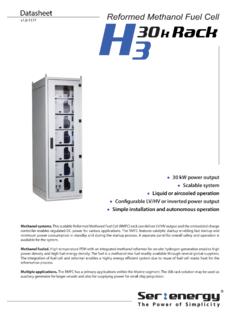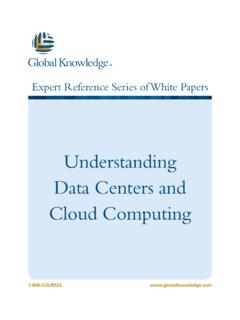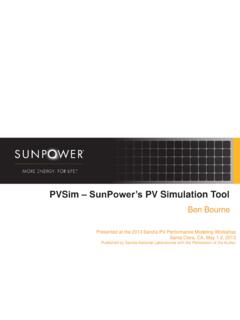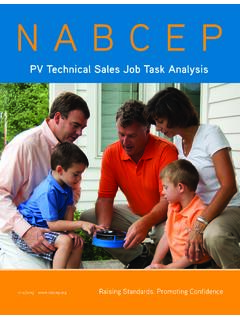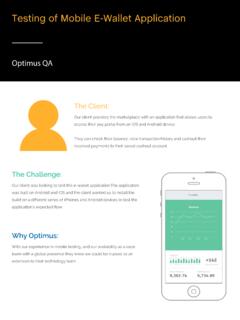Transcription of ASC Freshwater Trout Standard Version 1.0 February 2013
1 ASCF reshwater TroutStandardVersion 20132 Copyright NoticeASC Freshwater TroutStandard byAquaculture Stewardship Councilis licensed under aCreativeCommons Attribution-NoDerivs Unported beyond the scope of this license may be requested address:Aquaculture Stewardship Box 191073501 DCUtrechtThe NetherlandsTrade registernumber 343896833 Document controlThe Aquaculture Stewardship Council is responsible for thisdocumentVersion:Releasedate:Effectiv edate:Remarks/ , 2014 March, 2014 Update of the Standard to further meet lay-outrequirements. No content adjustments ,2013 February ,2013 Update of the Standard to meetASC style requirements( inclusion of introduction chapters about the ASC and overview of the ASC system , formatting andwording). The content of the actual Standard remainedunchanged from Version ,2013 January,2013 Originalversion developed and approved by the Freshwater Trout Aquaculture Dialogue Steering Committeeunder the original title Final draft standards forenvironmentally and socially responsible Trout farming Handover of the Standard by the Freshwater TroutAquaculture Dialogue Steering Committee to theAquaculture Stewardship theAquaculture Stewardship Council (ASC)ASC is the acronym for Aquaculture Stewardship Council, an independent not for profit ASC was founded in 2009 by theWWF(World Wildlife Fund) andIDH(The Sustainable TradeInitiative) to manage the global Standard for responsible aquaculture.
2 ASC s Standard were firstdeveloped by theAquaculture Dialogues,a series of roundtables initiated and coordinated by the ASC isThe ASC's aquaculture certification programme and label recognise and ASCis a global organisation working internationally with aquaculture producers,seafood processors, retail and foodservice companies, scientists, conservation groups, social NGOsand the public to promote the best environmental and social choice practices in the ASC doesWorking with partners, the ASC runs a programme to transform the world's aquaculture markets bypromoting the best environmental and social aquaculture performance. The ASC seeks to increasethe availability of aquaculture products certified as sustainable and responsibly produced.
3 The ASC scredible consumer label provides third party assurance of conformity with production and chain ofcustody Standard and makes it easy for everyone to choose ASC certified achieve this, the ASC programme is:Credible:ASC standards are developed and implemented according to ISEAL guidelinesbeing therefore multi-stakeholder, transparent, incorporating science-basedperformance :By includingscience-based performance metrics, the requirements in thestandards are realistic, measurable and :A globally recognised, market-oriented programme that aims to promotemeaningful improvements in aquaculture production in a credibleand cost efficientway that adds real value to producers and buyers of certified of the ASC SystemThe ASC system is made up of 3 components:1.
4 Aquaculture Farm StandardThe ASC works with independent third-party certification organizations that provide certificationservices for aquaculture operations that grow one or more of the species for which the requirementshave been, or are being, developed by the Aquaculture species groups were chosen because of their potential impact on the environment and society,their market value and the extent to which they are traded internationally or their potential for suchtrade. The species covered include: abalone, bivalves (clams, oysters, mussels and scallops), cobia, Freshwater Trout , pangasius, salmon, seriola, shrimp, and the Aquaculture Dialogues more than 2,200 people have participated in the development ofthe ASC Standard including fish farmers, seafood processors, retailers, foodservice operators,NGOs, government agencies and research institutes.
5 Universal, open and transparent, theAquaculture Dialogues focused on minimising the key environmental and social impacts ofaquaculture. Each Dialogue produced requirements for one or a range of major aquaculture speciesgroups. The Standard creation process followed guidelines of the ISEAL Alliance theISEAL Code ofGood Practices for Setting Social and Environmental Standard . This code of good practice complieswith the ISO/IEC Guide 59 Code of good practice for standardization, and the WTO TechnicalBarriers to Trade (TBT) Agreement Annex 3 Code of good practice for the preparation, adoption andapplication of standards . The requirements are science-based, performance-based and metrics-based and will apply globally to aquaculture production systems, covering many types, locations andscales of aquaculture 3rdParty Audits Conducted by accredited Conformity Assessment Bodies(CAB)Farms that seek ASC certification hire a CAB (conformity assessment body) that has beenaccredited by Accreditation Services International GmbH.
6 (ASI). Only farms that are certifiedby aCAB accredited by ASI are eligible to sell certified product into a recognized chain of custody andhave that product eligible to carry the ASC is the process by which CABs are evaluated to determine their competency to providecertification to the ASC Standard . The accreditation process includes annual evaluations of eachaccredited CAB and the ASC audits they perform. ASC has exclusively appointed ASI to provideaccreditation services for ASC. ASI is fully independent of ASC. ASI is based in Bonn, Germanyand also provides accreditation services to Forest Stewardship Council (FSC) and MarineStewardship Council (MSC). Despite similar sounding names, all of these organizations areindependent of is responsible for evaluations of CABs against the requirements in this document.
7 Allaccreditation decisions are taken independently by ASI. The independence of ASC, ASI and theCAB ensures that high quality, objective audits and certification decisions are performed without biasfor all clients around the MSC Chain of Custody Certification and the ASC LogoThe ASC logo has been developed for use by certified and licensed farms, processors anddistributors so that all parts of the value chain and especially consumerscan easily identify ASCcertified product(s). The use of the ASC logo can be applied only to products that are sold through aconsecutive, certified chain of custody that ensures traceability of certified products from productionto final point of ASC, chain of custody is certified through application of the MSC chain ofcustody system, to which ASC CoC requirements have been added as a scope, to ASC certifiedaquaculture products.
8 Only products that originate in ASC certified farms and are sold through anMSC certified chain of custody (with ASC CoC scope) are eligible to carry the ASC as with the ASC Standard , the ASC logo is owned by ASC which regulates all aspects of of contentDocument the Aquaculture Stewardship Council (ASC)..4 Overview of the ASC and scope of the fresh water Trout of the of the for creating the 1: COMPLY WITH ALL NATIONAL AND LOCAL LAWS AND :Operate within the legal framework of national and local laws and regulations thatare applicable and 2: CONSERVEHABITAT AND and location of buffer of exotic from culture 3: MINIMIZE NEGATIVE EFFECT ON WATER Use/Abstraction systems-Water Systems-Water Quality/Benthic 4: PROACTIVELYMAINTAIN THE HEALTH OF CULTURED FISH AND MINIMIZETHE RISK OF DISEASE health and 5.
9 USE RESOURCES IN AN ENVIRONMENTALLY EFFICIENT AND and transparency of raw materials in origin of marine raw on wild-caught marine ingredients in origin of non-marine raw materials in consumption and greenhouse gas emissions (on farm)..36 Criteria chemical 6: BE SOCIALLY , bonded or compulsory in the work environment health and to freedom of association and the right to collective and working with 7 REQUIREMENTS FOR FINGERLING AND EGG I: Assessment data needed to comply with ASC Freshwater Trout II: Methodologies related to Principle 3 Water II-A: Methodology total phosphorus discharged per ton of II-B: Water quality sampling methodology and data sharing for II-C: Sampling methodology for Benthic macro invertebrate II-D: Sludge BMPs for land-based systems (RAS/recirculation and flow-through).
10 53 Appendix II-E: Assimilative capacity assessment cage : Classification of cage II-G: Receiving water monitoring for cage-based II-H: Trophic status classification and determining baseline trophic III: Feed resource calculations and Forage Fish Dependency Ratio Calculation of EPA and DHA in IV Measures to prevent proteinworldwide. Byvolume,approximatelyhalfoftheseafoodwe eatiswildcaught. Buttheother half isfromaquaculture the fastest-growingfoodproductionsystemin theworld and aquaculture withmanyrapidlygrowingindustries,thegrow thinaquacultureproductionhas raisedconcernsaboutnegativesocial andenvironmentalimpactsrelated to farming, suchaswaterpollution,thespreadof diseasesandunfair labor practices atfarms. Althoughsomeproducersare addressingtheseissues well,others arenotdoingsoatallor a global Standard includingrequirements (performancelevels)thatmustbereachedtohe lpminimizeor , incorporatedintoexistingcertificationpro grams, adoptedforgovernment programs foran independent, auditable (FTAD)roundtablehas createdaglobal,performance-based Standard forfreshwatertroutfarming.



